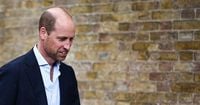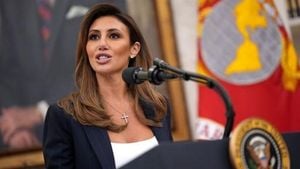Britain’s royal family is once again in the spotlight, but this time it’s not for a grand celebration or a regal ceremony. Instead, the news centers on a move that could reshape the very heart of the monarchy. On August 21, 2025, it was confirmed that Prince William, the future king, and his family will soon leave their current four-bedroom home on the Windsor estate and settle into Forest Lodge, an imposing eight-bedroom mansion dating back to the late 18th century. This isn’t just a change of address—it’s a decision with ripples reaching all the way to Buckingham Palace, the iconic London residence that has symbolized the British crown since 1837.
The Sun newspaper first broke the story, citing a source close to the couple who described Forest Lodge as William and Catherine’s “forever home.” The mansion, significantly larger than their current residence, offers more space for the couple and their three children—George, 12, Charlotte, 10, and Louis, 7—who already attend a nearby school. According to AFP, a Kensington Palace spokesperson confirmed, “the Wales family will move house later this year,” though they declined to share further details. The couple, insiders revealed, are footing the bill for the renovations, the move, and the rent themselves, a gesture seen as both personal and practical. After Catherine’s 2024 cancer diagnosis and treatment, the family is said to be seeking a “fresh start.”
Yet, as the Wales family prepares to put down permanent roots at Windsor, questions swirl about what this means for Buckingham Palace. For nearly two centuries, sovereigns have lived at the grand 755-room palace, hosting everything from summer garden parties to state banquets. It’s a building as recognizable as the White House, and, during summer months, parts of it open to the public, drawing in around 500,000 visitors each year, as noted by royal expert Richard Fitzwilliams in XCatalunya.
But as of now, Buckingham Palace is in the midst of a massive $429 million (£369 million) renovation, with completion not expected until 2027. The late Queen Elizabeth II moved out during the works, ultimately spending her final years at Windsor Castle before her passing in 2022. King Charles III, now 76, also does not reside at Buckingham, preferring the more intimate Clarence House, where he has lived since 2003. In early 2024, Charles announced his own cancer diagnosis, and while he has stated intentions to make Buckingham Palace his London base after renovations, royal commentators are not so sure. As Fitzwilliams told AFP, “It is the intention of King Charles and Queen Camilla to do so [move to Buckingham Palace] although given that he is battling cancer, this may well not happen.”
The move by William and Catherine is not without precedent; the royal family’s property portfolio is extensive. The late Queen favored Windsor Castle and Balmoral Castle in Scotland, retreating to the latter every summer. Christmases unfolded at Sandringham House in eastern England. King Charles, meanwhile, has lavished attention on Highgrove House in western England, transforming its gardens, and spends time at Birkhall on the Balmoral estate when in Scotland. Other royal properties include the Palace of Holyroodhouse in Edinburgh, Anmer Hall on the Sandringham estate, and the grand apartment 1A at Kensington Palace in London.
This abundance of residences is not without its critics. “There is the danger the monarchy is perceived to have too many homes,” Fitzwilliams warned in comments to AFP and The Daily Mail. Still, he was quick to add that “those who criticize the monarchy’s costs should note that the Buckingham Palace renovation is on schedule and not exceeding its budget.”
For William and Catherine, the move to Forest Lodge is about more than just square footage. According to reports from The Sun and confirmed by Kensington Palace, the couple is determined to raise their children in a more intimate, grounded environment, away from the relentless scrutiny and formality of central London. The hope is for a fresh start, especially after the challenges of Catherine’s illness.
Yet, the decision has sparked real concern about the symbolism and future function of Buckingham Palace. “It would be a disaster if Buckingham Palace were sidelined,” Fitzwilliams told AFP. “It is an iconic building, comparable only to the White House and known worldwide.” He stressed that, regardless of where William and Catherine choose to live, “it absolutely must remain the centre of the monarchy.” Others, like Daily Mail columnist Amanda Platell, worry about the optics of a less visible heir apparent. As she wrote, “I fear a future part-time king hiding away in Forest Lodge … could result in an even greater collapse of support among his subjects.”
Such fears aren’t unfounded. A YouGov poll from 2024 found that only 35% of 18- to 24-year-olds supported maintaining the monarchy, a number significantly lower than the broader population’s “fairly broad” support. As the monarchy navigates the 21st century, maintaining public engagement—especially among younger generations—has become an increasing challenge.
Still, William appears keen to modernize royal traditions. According to The Daily Mail, he is interested in opening up Buckingham Palace to even more tourists and expanding the range of royal events held there. This approach, some believe, could help keep the monarchy relevant and visible, even if the Wales family chooses not to reside within its walls.
Meanwhile, King Charles continues to focus on his health and his passions. From Clarence House, he has devoted himself to ecological projects and gardening, a quieter existence compared to the bustle of Buckingham Palace. But the question remains: when the renovations are complete and the dust settles, will the monarchy’s center of gravity return to its historic home, or will it shift permanently to Windsor and beyond?
As royal commentator Fitzwilliams put it, “Buckingham Palace would always have a vital role to play.” The palace’s fate, however, now seems more intertwined than ever with the personal choices of the royal family. Whether this new chapter for William, Catherine, and their children will mark a gentle evolution or a dramatic shift for the monarchy is a question only time—and perhaps public sentiment—can answer.
For now, the world watches as Britain’s future king and his family embark on a new beginning, even as the shadow of Buckingham Palace looms large over the royal landscape.




